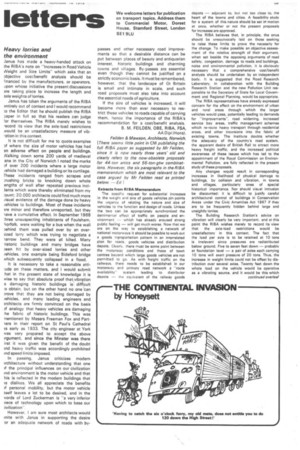Heavy lorries and the environment
Page 67

If you've noticed an error in this article please click here to report it so we can fix it.
Janus has made a heavy-handed attack on the RIBA's note on -Increases in Road Vehicle Neight and Size Limits" which asks that an objective cost/benefit analysis should be financed by the manufacturers, or operators. upon whose initiative the present discussions are taking place to increase the length and axle weights of lorries.
Janus has taken the arguments of the RIBA entirely out of context and I would recommend to the Editor that he should publish the RIBA gaper in full so that his readers can judge for themselves. The RIBA merely wishes to 'ecord its view that the axle-load restrictions would be an unsatisfactory measure of vib'ation in this context.
It is not difficult for me to quote examples of where the size of motor vehicles has had an adverse effect on people and buildings. Nalking down some 200 yards of medieval ane in the City of Norwich I noted the marks of over 200 incidents where a large motor iehicle had damaged a building or its dunnage. Mese incidents ranged from scrapes and 7.rushing bricks to knocking down whole engths of wall after repeated previous indilents which were thereby eliminated from my ;ount: 20,000 architects could find much more usual evidence of the damage done by heavy /ehicles to buildings. Most of these incidents are minor and therefore unreported, but they lave a cumulative effect. In September 1968 :hree unsuspecting inhabitants of Foulsham, %Jorfolk, were waiting for a bus when the wall oehind them was pulled over by an overaized lorry which was trying to negotiate a iarrow bend. They were all killed. Many listoric buildings and many bridges have oeen hit by over-sized lorries and other /ehicles, one example being Bideford bridge which subsequently collapsed in a flood.
It is necessary to take a reasonable atti:ude on these matters, and I would submit :hat in the present state of knowledge it is wise to say that absolute proof that vibration s damaging historic buildings is diffIcult :o obtain, but on the other hand no one can Drove that they are not being damaged by rehicles, and many leading engineers and architects are firmly convinced on the basis of analogy that heavy vehicles are damaging :he fabric of historic buildings. This was nentioned by Messrs Freeman Fox and Partlers in their report on St Paul's Cathedral as early as 1933. The city engineer at York was very prepared to accept the above irgument, and since the Minster was there irst it was given the benefit of the doubt Ind heavy traffic was accordingly prohibited Ind speed limits imposed.
In passing, Janus criticizes modern Irchitecture without understanding that one yf the principal influences on our civilization ind environment is the motor vehicle and that his is reflected in the modern buildings that le dislikes. We all appreciate the benefits )f personal mobility, but the motor vehicle tself leaves a lot to be desired, and in the vords of Lord Zuckerman is "a very inferior nece of technology upon which to base our :ivil izati on'.
passes and other necessary road improvements so that a desirable distance Can be put between places of beauty and antiquarian interest, historic buildings and charming towns and villages. By-passes are essential even though they cannot be justified on a strictly economic basis. It must be remembered, however, that the landscape of Gt Britain is small and intimate in scale, and such road proposals must also take into account the essential needs of agriculture.
If the size of vehicles is increased, it will become more than ever necessary to restrict these vehicles to roads capable of carrying them, hence the importance of the RIBA's recommendation for a cost/benefit analysis. B. M. FEILDEN, OBE, RIBA, FSA, AA Dip, I1-Ions), Feilden & Mawson, Architects, Norwich. I There seems little point in CM publishing the full RIBA paper as suggested by Mr Fellden, since it is now nearly three years' old and clearly refers to the now-obsolete proposals for 44-ton artics and 56-ton-gtw combinations. However, the six paragraphs in the RIBA memorandum which are most relevant to the case argued by Mr Fe//den read as printed below. -Ed. 1 However, I am sure most architects would mite with Janus in supporting the desire 'or an adequate network of roads with by




































































































































